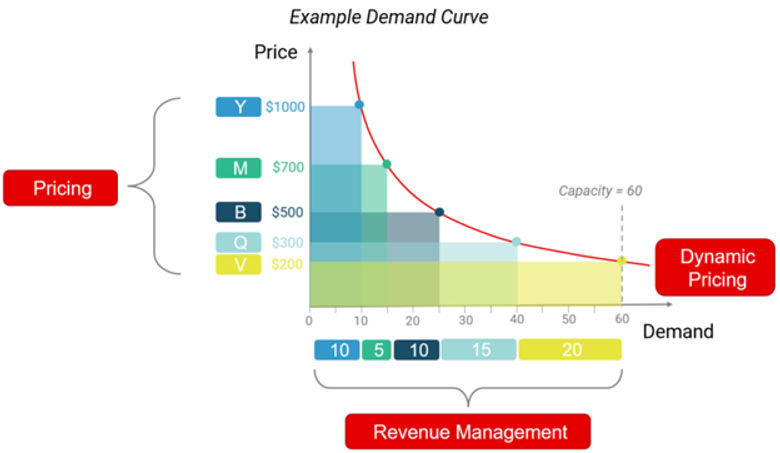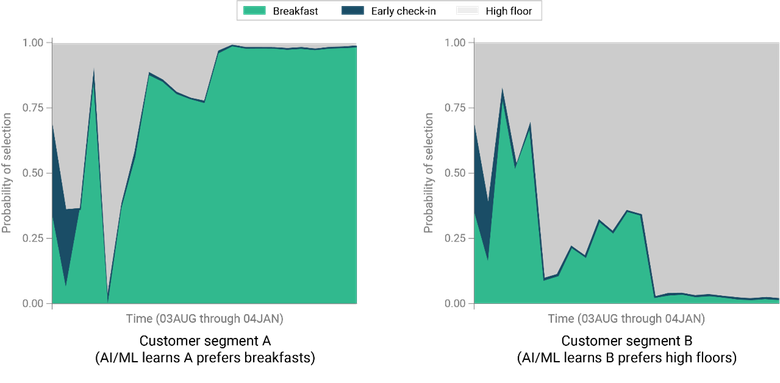Artificial Intelligence and Machine Learning (AI/ML) is an integral part of our daily lives, whether most of us realize it or not. Whether you use your social media feed on Facebook or LinkedIn, stream a movie on Netflix, or buy a product from Amazon, you interact with machine learning algorithms.
AI/ML technology has been widely used in the airline industry for decades and has a rich and growing history. Most of the most important departments in modern airlines use AI/ML technology at scale. Examples include airline network planning, flight scheduling, pricing and revenue management, operations and staffing planning.
Although AI/ML models have had a great impact on the airline industry, their early implementation had limitations. Previous architectures and development processes made it difficult to integrate different models, and significant manual intervention was required to update models with the latest data.
Leveraging a modern, cloud-based microservices architecture with improved scalability and automation, our new ML-based applications provide our airline partners with opportunities for increased revenue generation and improved customer service. There are five ways this technology is used.
1. Flexible price and availability of air transport
Airline variable costing is a term used in many different contexts. At Sabre, we refer to variable airfare pricing to describe an engine that helps airlines offer tailored offers to different customer segments, taking into account the airline’s revenue management controls and data signals in the current competitive market.
A close relative to variable cost is variable availability. With dynamic availability, instead of directly adjusting fares, the airline’s availability controls are updated (by closing or holding rooms). An airline’s ability to change prices on the fly with dynamic pricing offers maximum revenue performance, but today is limited to airline direct channels and NDC offerings. On the other hand, dynamic availability changes can be applied to all GDS sales channels, so while the revenue performance of each change is slightly lower, the overall applicable sales base is larger. So both approaches bring value to airlines.
Saber’s variable pricing and availability products have been shown to deliver up to 3% revenue gains. These profits are in addition to what the airline realizes from the revenue management system, which derives from more customized discount decisions, a series of price points instead of fare units (see the example) and the ability to manage prices better (i.e. it is at the journey level instead of the departure date only for traditional inventory control). This good quality, ongoing pricing benefits travelers because they can access new price points not previously supported. See Saber Air Price IQ and Saber Dynamic Availability for more information.

2. Variable cost of air assistance
One of the biggest trends in airline marketing over the past decade has been the strong and steady growth in sales of air travel aids. In the year According to a report from IdeaWorks, since 2013, airline ancillary revenue trends have averaged more than 15 percent annual growth. Corresponding sales growth during this period comes from both individual ancillary sales (a la carte) and the expansion of the airline’s branded fares.
In the past, ancillary prices were a secondary consideration for airline marketing teams, and those prices remained largely unchanged across airline regions. But as sales (and revenue) increasingly shift to assistantships, the opportunities for more flexible pricing with AI/ML technology have grown. AI/ML models can help airlines recommend optimal prices for additional products or services using supervised learning (estimating price elasticity and based on market segment, seat type, cabin space, etc.) and reinforcement learning methods. “Test Engines” section below).
In practice, our clients have seen up to 10% additional ancillary revenue from AI/ML models for both variable cost reductions and ancillary increases. For more information, see Saber Ancillary IQ.
3. Test engines
Based on a type of AI/ML known as reinforcement learning, the new test engine platform offers exciting opportunities for all traveling salespeople. Traditional AI/ML models build complex predictive models based on historical data. Test engines, however, do not rely on extensive historical data; You will try several options and see the results. The models learn from those results so the parameters that generate the results are adjusted slightly, and the process can be repeated (and again and again).
An example use case is Saber Hospitality’s SynXis Retail Studio Hotels application, which has many similarities to airline retail applications. A hotel can have many different ancillary products and choosing the right one to offer to each guest is a complex problem.
The graphs below show how the test engine model knows which product to offer to two different customer segments, A and B. First (see the graphs on the left), the model provides all three products. Over time, he settles on a clear solution: A chooses breakfast and B chooses a higher floor. The model learns as it gets more data points (from impressions and clicks), so the ‘exploration’ level can be reduced as it gains confidence in the best products to be seen.
Example of hotel assistant optimization – automatically finding the best customized offer for each customer segment:

In practice, our hotel clients have seen gains of up to 30% in guest click-through rates when using Test Engine to assist with display decisions. For more information, see SynXis Retail Studio.
4. Market size forecast
When designing future schedules, two of the most important questions in airline network planning are, “Where do people want to go?” and “How many people want to travel between those origin-destination pairs?” If we know both answers, we know the demand for travel, and therefore can help optimize the supply of travel (ie determine the number of aircraft needed, where to fly and how to schedule them). This means we can build systems that estimate expected revenue and profitability, optimize retail and distribution strategies, plan resources, etc.
“How many people want to travel from city A to city B?” Answer correctly. Important for aircraft manufacturers, airlines, hotel operators, travel agencies, local businesses, tourism and the investment community. Between them there are about 250,000 urban couples who have air service, and their travel needs are changing every month; So it is almost impossible to answer that question by manual market analysis.
This is where Sabre’s new network planning tools can help. The Saber Labs team is working on an AI/ML model known as “market potential forecasting” that predicts how many people will travel from A to B per month for 250,000 markets. The underlying AI/ML model is trained on both historical trends and prospective air low-cost search transaction data. Saber Kuni Kaya explains more in this latest article.
By combining historical data, analyzing segment characteristics and prospective purchase data, our AI/ML-based market potential forecasting model has the potential to increase average forecast accuracy to >90% for customers using our solutions.
5. Returning a damaged passenger flight
Some of the most common disruptions airline passengers face are flight cancellations and delays, but there are other types of disruptions. Saber AI/ML models for hospitality during non-routine operations such as unplanned flight schedule changes, cancellations, etc. can assist in providing new itineraries for international access, passenger prioritization and accounting for airline operations.
These AIA/ML models can be used as a “what if” tool by which airline analysts can evaluate the effect of a particular cut (change of equipment to a less capable aircraft). Based on the solution, you can decide if this is an acceptable action to take. If the tool is used and the results are applied, passengers will automatically be guaranteed a ticket in the new itinerary, as the rebooking process will handle this.
Whenever an IROPS application is submitted and passengers are informed of their new itinerary, passengers decide whether the new trip is something they still want to take, or choose to reschedule or cancel it altogether.
A business woman who has an important meeting on Monday morning cancels it rather than taking an alternative itinerary to arrive by lunchtime on Monday. A person on a week-long vacation in Italy may be eligible to re-register to arrive half a day later. Experienced analysts can recognize some of these patterns and offer only the return options that can satisfy travelers. To further assist airline analysts, Saber developed a machine learning model to help assess whether a replacement itinerary would be acceptable.
In practice, some airline customers have seen significant improvements in passenger satisfaction and call volume reductions of up to 25 percent. For more information, see Saber IROPS Reaccommodation.
Choosing the right AI/ML
Not all AI/ML are created equal, which is why Saber Travel AI is powered by cloud-native, microservices-based machine learning applications powered by a best-in-class unified AI platform for offers and orders: Vertex AI from Google. In the airline industry, making the right decisions at the right time can mean the difference between turning a discount into revenue or not. Advanced testing using Vertex AI ensures that airlines can create personalized and contextual offers for travelers, which increases the likelihood that those offers will convert and create value for both travelers and airlines.
[ad_2]
